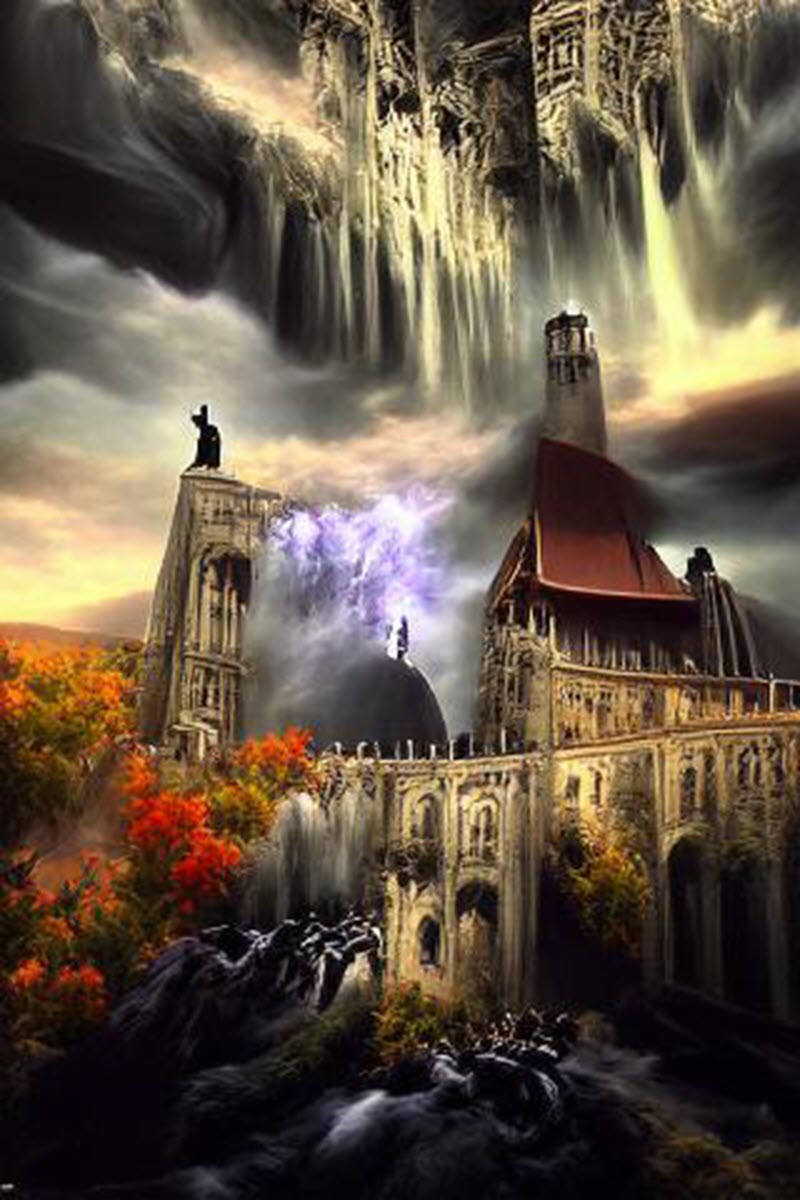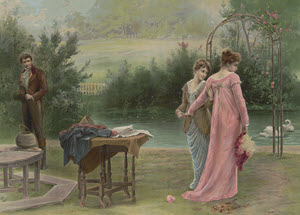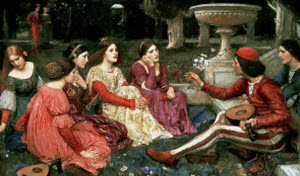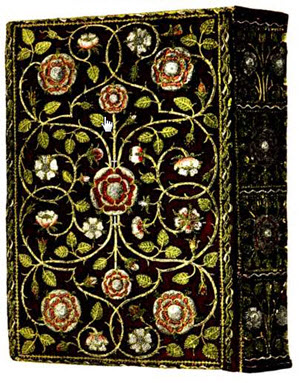THE FALL OF THE HOUSE OF USHER
SUMMARY OF THE FALL OF THE HOUSE OF USHER:
The Fall of the House of Usher is a masterpiece of American gothic literature. Like many of Poe's works, it deals, at least partially, with the fear of being entombed alive. In the story, the narrator visits the home of his friend and his twin sister, who are both suffering unnamed maladies. The house they live in casts a gloomy spell on all within it and the Usher, the narrator's friend says that he belives that the house is sentient. In the end, the brother and sister are destroyed and the house splits in half and collapses as the narrator escapes.

Disturbed by the urgent letter of the childhood friend Roderick Usher, the nameless first-person narrator rides to his estate, the House of Usher, which gives a disturbing and frightening impression through its ghostly environment, in particular the pond from which it rises, as well as through a crack that runs through the walls. It also tells of the lake where the House Usher is located. Demonic figures are to come up and fetch the one who stares at the lake for too long.
There, the narrator meets the nervously overstimulated landlord, apparently suffering from a mental illness, the last offspring of a degenerate noble family. Roderick Usher asks his visitor to keep him company for some time to make his illness more bearable. Shortly thereafter, the host's twin sister, Lady Madeline, allegedly dies and is laid out and buried in the basement of the house.
During a stormy night a few days later, the first-person narrator reads a supposedly cheering knight story to Roderick, who is nervously attacked and also sleepless, but ultimately only empowers the horror of the eerie noises in the house. Through the course of the knightly story and the accompanying sounds as well as the subsequent confession of Roderick, it becomes obvious that Roderick must have buried his sister alive. Suddenly, Lady Madeline is covered in blood in the door; she throws herself dying at the brother, who dies immediately from the shock.
In a panic, the first-person narrator flees from the property and still sees how the crack that runs through the house widens further and further apart until it collapses and sinks into the lake.
Meaning
Poe had spent several years in Scotland and England in his youth and had gone to school there. The still existing world of the nobility with its long history made a deep impression on the young American writer and poet, who felt almost history-less in comparison.
At the same time, Poe designs and uses some of his favorite motifs: mental illness, opium intoxication, love among close relatives, being buried alive, the resurrection of those believed dead or the death of a beautiful young woman. The fact that he not only arranges these motifs for the purpose of increasing the effects, but also works through them partly from his own life story, also makes a story like that of the downfall of the House of Usher biographically interesting.
The title of the story not only refers to the central event, i.e. the "fall" or downfall of the Usher family due to the death of the siblings Roderick and Madeline, but also contains a double reference to the ushers' house, which actually collapses in the end and sinks into the mountain lake. The importance of space and the interrelationship between man and space are one of the author's most important design principles in this narrative.
The first-person narrator begins his story with the first sight of the house he visits at the request of his childhood friend Roderick Usher, and concludes it with a look back at the collapsing building, from which he escapes in horror. In between is the depiction of the growing psycho-physical decay of the main character Roderick, the sudden death of his twin sister Madeline as well as her mysterious burial in the underground vault of the house and the subsequent ghostly reappearance of the dead Madeline in an eerie night, which then results in the common end of the sibling couple.
The limited perspective of the first-person narrator, who as an outsider is not fully privy to the background of the processes he describes and therefore only has a more or less superficial understanding of the connections due to his own analysis and combination of the facts accessible to him, creates the narrative impression of a complexity in which much is still puzzled or undiscovered or unsaid, and thus contributes to an essential tension of this story of Poe. Likewise, the narrator's predominantly rational attitude suggests that the irrational depth dimensions of events cannot really be tapped by him. In this way, the form and conception of the narrative appears to the reader from the outset to be in need of supplementation; the reader is thus stimulated over long distances to his own speculations and combinations in order to understand the significance of the events depicted.
However, the narrator's common sense and his skepticism of supernatural appearances also creates the appearance of authenticity in his descriptions; his increasing concern by the eerie processes and the appearance and behavior of Usher transfers the gruesome atmosphere of the house all the more impressively to the reader. On the external level of events, it is precisely through the emotional and intellectual overwhelming of the narrator that the processes acquire a special power of persuasion or verisimilitude at the end, which Poe tried to implement in accordance with his theoretical ideas about the short story.
The impression of the ambiguity and irrationality of the events is also decisively deepened by the enigma of the main characters and their relationships to the spatial and human environment. The appearance offered to the narrator as well as the reader is characterized by numerous inconsistencies and strange or mysterious features that provide both a supplement and a variant to the narrative perspective. Roderick Usher's physical and mental state is characterized by a morbid sensitivity and nervous excitability, which make an ultimately fatal catastrophe seem inevitable right from the start. The narrator's contrast of the past and now underlines the crisis-proneness of the situation presented and the decay of his personality.
Roderick's mood constantly fluctuates between lively open-mindedness and annoyance as a sign of his "mental disorder",which is equally expressed in the pathological sensitivity of his senses. For example, he can only sit in darkened rooms, only listen to violin music, eat only weakly spiced food and wear special fabrics. At the same time, however, Roderick's artistic products (characteristically, the narrator speaks of him as an artist) are signs of the intensity of his "mental collectedness and concentration"[7],thus an intensity and concentration of his imagination and thinking. On the other hand, the narrator expressly emphasizes several times the detachment of the products of Roderick's artistic imagination in his paintings, poems or musical interpretations from all normal social, temporal or spatial references, thus in turn emphasizing the absence of any ordinary relationship between Roderick and (everyday) reality. Despite all the fantasy, Roderick's works nevertheless testify to a strange clairvoyance and reflect an objectively correct insight into his own mental and spiritual state.
The central theme of the decline of the personality in The Fall of the House of Usher is mirrored and emphasized by Poe in the sense of the "single or unique effect" he calls for in a series of analogous processes in the human and extra-human realm. [9] In Poe's cosmological conception, the exterior and interior, the material and the immaterial, the animate and the inanimate are equated with a "sentience",i.e. a sensual sentience of things, which is also made clear to the reader by the corresponding statements of Roderick Usher after his performance of the ballad.
The "language of things" is already audible at the beginning of the narrative and, as in other of his stories, serves Poe to design the space: the fine crack in the masonry finds its counterpart in the first signs of disintegration in Roderick's inconsistent behavior. The atmosphere that surrounds the entire building is parallelized on the human level by the narrator's associations of illness and decay; in Poe's orientation of the spatial design towards the comprehensive whole, the symbol is "not an isolated or isolatable object", but "part of an expressive wholeness", in which the invisible, mysterious forces of the space are represented suggestively-atmospherically in an almost allegorical form and thus in the narrative for the intensification and dramatization of interpersonal relationships as well as the relationships between people and the inorganic and organic world.
The design principle of correspondences and parallels (Roderick's inner and outer state, correspondence between house – inhabitant, house – lake) can also be found in the constellation of figures in the narrative; the parallels between Roderick and Madeline, both inside and out, are made particularly haunting on different levels in the form of the twin motif. At the end of the story, the symptoms of the disease are also exchanged: Roderick appears frozen, while Madeline's appearance shows the signs of a high degree of inner excitement.
The parallelism of the two characters at the end of the story is most evident in their common death, which at the same time gives the reader an idea of why Madeline, the seemingly dead, could not die before: as a "second self" she was, so to speak, externally and internally bound to Roderick.
The relationships between the house and its inhabitants and, above all, between Roderick and his sister, which are impressively reflected in the last scene, raise a number of questions that focus in particular on the peculiar relationship or bond between the siblings and have led to different interpretations or readings of the story. Read as a horror story, Madeline can be seen as a vampire who "sucks out the blood of life" and vice versa within the framework of the genre-typical motifs. From a depth psychological point of view, however, Madeline becomes the "dark underside" or the unconscious "evil" in Roderick, which may be based on an incest relationship that is not clearly expressed in the narrative. Likewise, Madeline has been interpreted in the sense of Freud as the embodiment of Roderick's death instinct, which is contrary to his instinct for life.
Whether one may follow the interpretation of Marie Bonaparte, who sees in the house of Usher and in the figure of Madeline the dead mother avenging for the breach of fidelity of the son, is therefore also dependent on the attitude to psychoanalysis.
Adapted and translated from https://de.wikipedia.org/wiki/Der_Untergang_des_Hauses_Usher
For the online text of the Fall of the House of Usher, click here.
2021
Complete Works of Edgar Allan Poe Online: Poems of Edgar Allan Poe | Works of Edgar Allan Poe - volume 1 | Works of Edgar Allan Poe - volume 2 | Works of Edgar Allan Poe - volume 3 | Works of Edgar Allan Poe - volume 4 | Works of Edgar Allan Poe - volume 5 |




